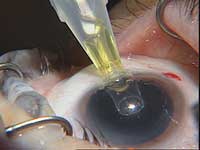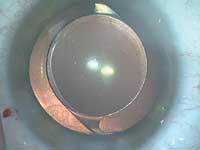AcrySof Natural IOL can protect retina, improve vision quality, surgeon says
A yellow chromophore filters blue radiation similarly to an adult natural lens, giving more natural light and color perception, according to one physician.
The Alcon AcrySof Natural IOL protects the retina from the toxic effect of blue light and at the same time improves quality of vision, according to Pierre Levy, MD, speaking at the French Society of Ophthalmology meeting. The lens received Food and Drug Administration approval in June for marketing in the United States.
“Patients report a general feeling of visual comfort, with less glare, a softer perception of light and a more natural color vision. In case of unilateral cataract, they don’t feel any difference between the operated and the unoperated eye,” he said.
The concept of a yellow-pigmented lens developed from studies showing the toxicity of blue light on the retina and the correlation between prolonged exposure to blue radiation and the development of age-related macular degeneration.
“The Beaver Dam Eye Study has demonstrated that there is a greater incidence of AMD over a period of 10 years in aphakic and pseudophakic eyes. One of the reasons is that in removing the natural lens, cataract surgery removes the yellow filter of the opacified lens and the other filters that normally protect the retina. Artificial lenses have a UV filter, but not a filter for blue light,” Dr. Levy said.
Because of the increased sensitivity of the eye to short-wavelength radiation, color vision is also progressively altered in aphakic and pseudophakic patients, under both photopic and scotopic conditions.
More natural perception
In the AcrySof Natural IOL, a yellow chromophore suppresses blue radiation, so that the lens has light-absorption characteristics similar to that of a healthy, natural crystalline lens.
“We can therefore assume that the AcrySof Natural has a protective effect on the retina,” Dr. Levy said.
Reports have shown that the quality of vision, with better color perception and contrast sensitivity, have subjective positive effects on patients’ quality of life.
The lens is currently being evaluated in several clinical studies to find objective evidence of its efficacy. Preliminary results are “very promising,” according to Dr. Levy.
He said Niwa, in 1996, demonstrated an improvement in contrast sensitivity and a decrease of glare both in mesopic and scotopic vision with blue light-filtering PMMA lenses, compared to UV filter lenses.
“Implants with UV filter produce chromatopsia, cyanopsia and, in most cases, a distortion of color perception turning towards blue,” Dr. Levy said.
Personal experience
In France, 15,000 AcrySof Natural IOLs lenses have been implanted since September 2002. A pilot study evaluated the results of 4,000 IOLs implanted in 10 centers. A multicenter study on quality of vision and quality of life is currently ongoing in six centers since May 2003. Dr. Levy has implanted 500 lenses since September 2002.
|
“I am very satisfied with the performance of this implant,” he said.
The advantages are visible from the very first stages of the implantation procedure, he said.
“Injection is easier thanks to the yellow color of the lens, which makes it more visible when you load it into the cartridge and when you place it through the incision,” he said.
Postoperatively, the patient’s perception of colors is not altered, and the cosmetic outcome is as good as with other lenses, he said. When unilateral cataract surgery was performed, no difference was reported in color vision between the two eyes. Subjectively, patients were satisfied, and fewer complaints of glare, chromatopsia and harsh colors were reported compared to other implants.
“Patients feel less assaulted or dazzled by light, as sometimes happens with other IOLs,” Dr. Levy said.
Compared with traditional IOLs, slit-lamp examination revealed a faint yellow reflex, which did not affect fundus examination. During fluorescein angiography, no difference was reported with red and green light, but a slight difference with blue light, which did not alter the quality and interpretation of the images.
Missing element
“In conclusion, there are no negative effects produced by the blue light-filtering chromophore of the implant, and objective results are comparable with those of traditional AcrySof lenses,” Dr. Levy said.
Surgeons who doubt that a yellow lens can be as transparent as a traditional lens should be reassured by these results, he said; there are no problems but considerable advantages.
“If the positive effects of the implant in terms of retinal protection are something we can demonstrate better in theory than in clinical practice, because the origin of AMD is still partly unknown and is multifactorial, the positive effects on the subjective visual perception of our patients are real and unequivocal,” he added.
He said that filtration of blue light is, after all, a natural phenomenon. The ozone in the atmosphere, the cornea, the crystalline lens and the yellow pigment of the macula naturally protect the eye from blue radiation. During surgery, the eye is protected by the yellow filter of microscopes.
For Your Information:
- Pierre Levy, MD, can be reached at 60 place Jaques Mirouze, Espace Pitot, 34000 Montpellier, France; +(33) 04-67-63-07-76; fax: +(33) 04-67-54-65-66; e-mail: levypierre@wanadoo.fr. Dr. Levy has no direct financial interest in the products mentioned in this article, nor is he a paid consultant for any companies mentioned.
- Alcon, maker of the AcrySof Natural IOL, can be reached at 6201 South Freeway, Fort Worth, TX 76134 U.S.A.; +(1) 817-293-0450; fax: +(1) 817-568-6142.
References:
- Klein R, Klein BE, et al. The association of cataract and cataract surgery with the long-term incidence of age-related maculopathy: the Beaver Dam eye study. Arch Ophthalmol. 2002;120:1551-1558.
- Niwa K, Yoshino Y, et al. Effects of tinted intraocular lens on contrast sensitivity. Ophthalmic Physiol Opt. 1996;16:297-302.


